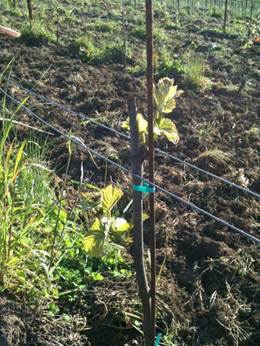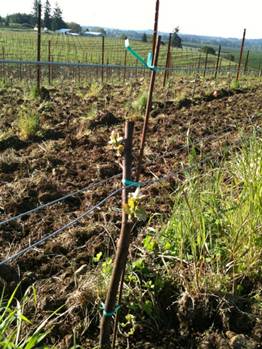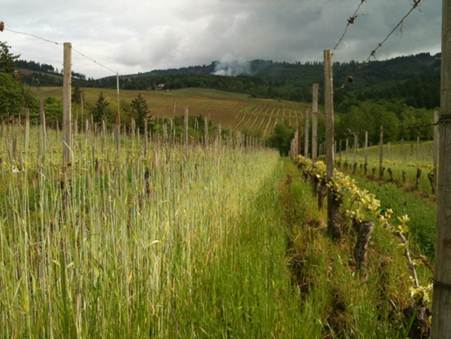Growth and Cover Crops
- Bud break finished about 2 weeks ago and we are starting to see some leaves unfold and inflorescence becoming visible. Vineyards vary in phenology from 1 leaf separated through to 4 leaves separated.
- Development is slower than I would like due to the cool wet temperatures (La Nina pattern)
- We are seeing some minor mite damage causing Short Shoot Syndrome (SSS).
- Over winter the mites live in the bud scales and emerge at the same time as the shoots.
- They tend to feed on the growing shoots causing stunted, zig-zagging growth, scaring in the internodes and leaves distortion.
- The shoots will out grow the mite’s ability to keep the shoot stunted but to do that we need nice warm weather.
- Damage is generally sporadic
Figure 1.

Figure 2. Short shoot syndrome

The two vines above were right next to each other in a young Pinot Noir block (4W) at Jacob Hart Vineyard. One showing strong healthy shoot growth and the other suffering from short shoot syndrome. We have treated this block with a light application of sulfur try and knock down the mite population. We will monitor the progress of effected vines and mite populations using double sided sticky tape wrapped around the trunk.
For those that are interested this website offers more information.
http://wine.oregonstate.edu/files/files/Short%20Shoot%20Symptoms%20of%20Grapes.pdf
Cover Crops
Fall cover crops
- We are now starting to work in our fall cover-crops of Winter Rye Grain and Vetch.
- These are planted in the rows that we cultivate to hold the soil in place over winter
- We also get the benefit of nitrogen fixation from the vetch
- Both these cover crops produce a great amount of biomass which is worked into the soil to increase organic matter content, soil life and quality.
- In the less vigorous areas we planted a combination of the two plants to increase soil fertility and possibly vigor (added nitrogen from the vetch)
- In the more vigorous areas we didn’t use vetch because we didn’t want the added nitrogen further increasing vigor.
Figure 3. Winter Rye grain planted in the Pinot Gris block at Jacob Hart.

Spring Cover crops
- We have planted buckwheat and wildflowers at many of our sites: Jacob Hart, REX HILL, Pearl, Sims, Foley and Domain Margelle.
- We have planted these for their flowering qualities. These plants will provide nectar for a variety of insects and birds increasing the diversity of life within our vineyards.
- Why buckwheat? Once mature it will flower for a long period of time producing large quantities of nectar. Buckwheat has been shown to increase numbers of predatory beneficial insects and reduce pest populations to below economic thresholds.
Figure 4. Recently germinated buckwheat at REX HILL vineyard.
Comments
Commenting has been turned off.Recent Posts
-
October 12, 2018
-
June 7, 2018
-
October 30, 2017
-
October 23, 2017
-
September 13, 2017
-
April 17, 2017
-
July 21, 2016
-
June 2, 2016
-
May 25, 2016
-
May 18, 2016
Blog Categories
Blog Archives
Our Writers
- Leanne Bellncula (2)
- Shelli Brinson Fowler (1)
- Tom Caruso (2)
- Ryan Collins (20)
- Bill Hatcher (10)
- Deb Hatcher (2)
- REX HILL (59)
- Kelly Irelan (1)
- Carrie Kalscheuer (3)
- Jonathan Lampe (3)
- Karina Lopez (1)
- Meredith McGough (1)
- Katie McLennan (2)
- Charlotte Mischel (2)
- Karen Peterson (2)
- Olivier Prost (2)
- Tom Reed (1)
- Emily Sadler (1)
- Sam Tannahill (2)
- Mike Willison (4)

